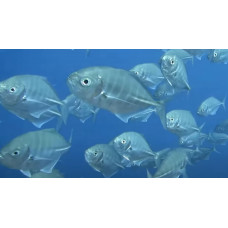Latin name
Carangoides ferdau
Other names
Banded trevally, barred trevally, Ferdau's trevally, Forskaal's jackfish.
Identification
In general morphology, this species is similar to a number of other trevallys of the genus Carangoides, having a compressed, elongated body with a dorsal profile more convex than ventral. Unlike most Carangoides, its snout is sharply rounded, reminiscent of the snout of pompano of the genus Trachinotus, and the lips of adults are conspicuously fleshy. The lateral line has a smooth anterior arc, with curved and straight sections meeting vertically under the 15-20 soft rays of the second dorsal fin. The curved portion of the lateral line contains 82 to 90 scales, while the straight portion has 12 to 17 scales and 26 to 31 spike. The pectoral fin is exposed to the beginning of the pelvic fins and the base of the pectoral fins, but is interrupted on the sides by a moderate band of scales. The upper jaw is very mobile and contains narrow rows of teeth that, like the lower jaw, become obsolete with age. It has a total of 24 to 29 gill blades and 24 vertebrae.
Features of fish fins
Blue trevally have two separate dorsal fins, the first with eight spines and the second with a single spine and 26 to 34 soft rays, larger than any other species of Carangoides. In juveniles, the blade of the second dorsal fin is often sickle-shaped, but is usually shorter than the length of the head. The anal fin has two anteriorly positioned processes followed by a process attached to 21 to 26 soft rays, while the pelvic fin has a single process attached to 20 or 21 soft rays.
Fish colouring
The body is bluish-green to yellowish-green above, silvery below, and adults have five or six dark vertical stripes that usually persist after death. Numerous inconspicuous golden spots are often present on the sides, usually above the level of the pectoral fins. The soft dorsal and anal fins are pale yellowish green, and the anterior lobes of both fins often have white to blue tips. The caudal fin is yellowish green with a darker posterior margin and tips, while the pelvic fins are whitish to hyaline.
Distribution
Widely distributed, inhabiting tropical and subtropical waters of the Indian, Western and Central Pacific Oceans. Its range extends from South Africa in the west, north along the coast of East Africa to the Red Sea, and through India and Southeast Asia. The species' range extends south to Australia and Indonesia, as well as Japan, Hawaii, and several Pacific islands, including Micronesia, New Caledonia, and Tonga.
Habitat
A marine, tropical species. It inhabits coastal waters up to 60 meters deep, reefs, beaches, lagoons and sandy bottom areas. This species is pelagic, which allows it to move between islands and atolls. It is rarely found in estuaries, indicating a low tolerance to low salinity.
Size
It is a medium sized fish, reaching a recorded maximum length of 70 cm and a weight of 8 kg. The normal length is about 30 cm.
Behavior
Often forms small schools.
Food and feeding habits
It is a fast swimming predator. It feeds on a variety of small fish (especially mackerel and filefish), crustaceans including shrimp, crabs and sea lice, soft shellfish and other prey.
Reproduction
No information is available on the reproduction and growth of this species, although larvae of this species are known to appear in February in waters off Taiwan, suggesting a spawning season in December. Juveniles are known to sometimes hide between the tentacles of large pelagic jellyfish.
Fishing
This species is commercially important in some areas because of its high abundance, or is more commonly used as bycatch in other major fisheries. It is mainly caught with hook and line, gillnets and various traps.
Relationship with a person
Blue trevally is considered an excellent food fish, although there have been rare reports of ciguatera poisoning.
| Classification | |
| Phylum | Chordata |
| Class | Actinopterygii |
| Squad | Carangiformes |
| Family | Carangidae |
| Genus | Carangoides |
| Species | C. ferdau |
| Features | |
| Conservation status | Least Concern |
| Habitat | Pelagic |
| Life span, years | No information |
| Maximum body weight, kg | 8 |
| Maximum length, cm | 70 |
| Sailing speed, m/s | No information |
| Threat to people | Edible |
| Way of eating | Predator |
Blue trevally
Tags: blue trevally


